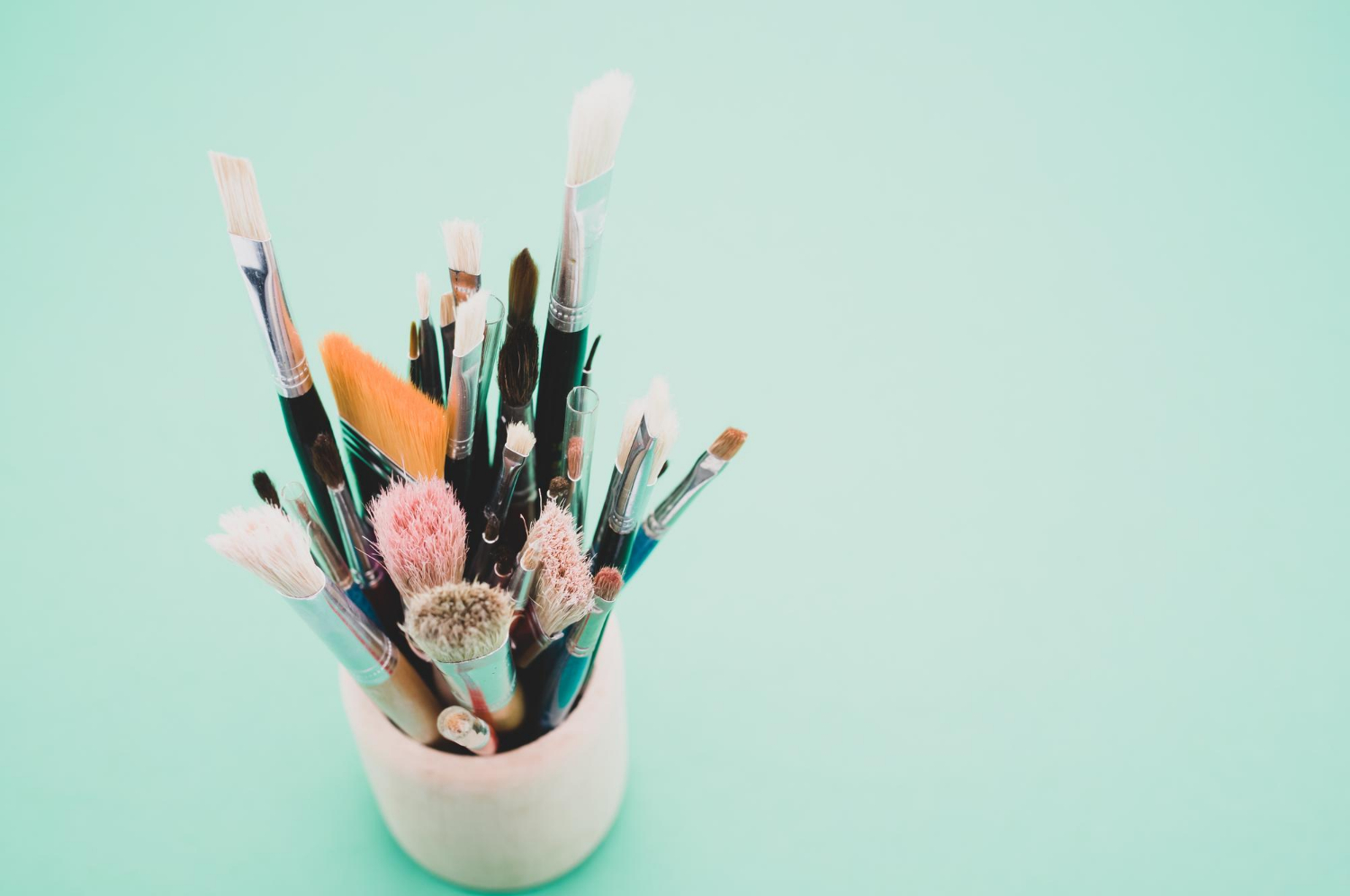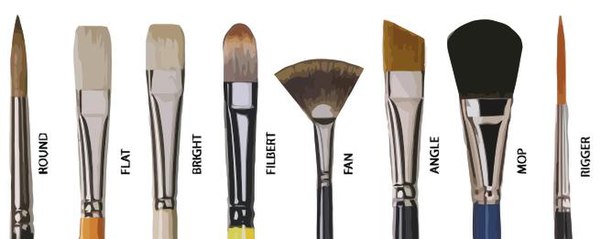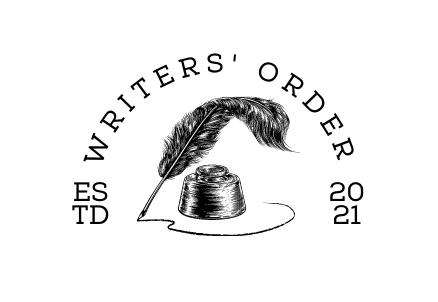You have to be the change to bring the change.

Different Types of Paintbrushes: A Detailed Guide
Our content is reader-supported. We may earn a commission if you make a purchase through one of our links.
Standing there in the art supply store, amongst the sea of different types of paintbrushes, can be overwhelming, even for experienced artists who know what they are looking for.
Whether you’re a beginner artist, just starting your painting journey, or an achieved painter looking to explore new avenues by exploring new brushes, you’ve come to the right place.
This article is about telling you all you need to know about various paintbrushes available in the market, what sort of paints or painting styles they are used for, and much more.
The Importance of Choosing the Right Paintbrush
Art is the embodiment of an artist’s soul. But have you ever thought of how a part of your soul flows out of your mind and heart, into your arms, continuing through your hands, to the fingers… where it meets the nexus between your body and the canvas: the paintbrush.
Your paintbrush is much more than a stick with bristles on one end. It’s the bridge between you and your art. Well, not if you’re painting with your fingers, but when you do use a brush, think of it as not just an art tool but a magic wand. Through it, you can convey the merriest of joys and even the glummest of blues.
Simply put, your paintbrush is very important! Not just because of its symbolic value, but the way it helps you create your art and bring out the best in you. Working with the right paintbrush will save you a lot of time and make the art-making process a breeze.
Besides choosing the right kind of brush, you must also realize the importance of working with high-quality brushes. If you want to create art that looks premium quality, work with premium quality brushes.
Good quality paintbrushes will save you a lot of paint, make painting a smoother process without having to switch between the canvas and palette often, make your paintings look better, and save you the aches and pains you might acquire working with a low-quality brush.
Moreover, good paintbrushes offer longer lifespans if cared for the right way and act as a long-term investment.
The Paintbrush Anatomy
- Bristles: Bristles are the most important part of the paintbrush. It’s the top part that constitutes the fine hair or filaments that absorb paint and apply it over the canvas. The bristles can be natural, made of animal wool, or synthetic. Often, paintbrush bristles are made from a combination of both.
- Ferrule: The ferrule is the shiny metallic part that connects the bristles to the handle. This part of a paintbrush is made from brass, tin, copper, or aluminum alloys with chrome or nickel coating. The ferrule is where you hold the brush while painting, and you will not be comfortable painting if it doesn’t fit in your fingers.
- Crimp: The crimp is the incised part of the ferrule near the handle. It clamps the ferrule onto the handle and holds the two firmly in place.
- Handle: This is the longest part of the brush and can be made from wood, plastic, bone, or a range of other materials. The handle helps counter the balance of the brush in your hands and makes it easier and more comfortable for you to paint.
Eight Different Types of Paintbrushes and Their Uses

1. Round Brush
The round brush is designed to give you more control over the flow of paint to the canvas. They can be used for a range of techniques, from thick and thin lines to fills and washes.
Round brushes are great for outlining, sketching, and detailed work, allowing you to fill in small areas. The pointed tip allows for great detail, but the paint movement can easily be thickened by pressing the brush down.
Round brushes are recommended to be used with thinned paint instead of thick paint. Other than the standard round brush, these also come in pointed-round varieties that offer greater precision.
The handle of a round brush is designed to make you feel as you’re holding a pencil and gives you more control. If you are painting and you feel the need for more control over the brush for detailed work, pull out the round brush.
2. Flat Brush
Flat brushes have squared bristles with medium-long length filaments. Using a flat brush should feel like using a mini-wash brush. Flat brushes come in handy when you’ve got a large area to cover with the paint, but it is not as large as to use a wash brush.
A flat brush is perfect for bold strokes and impasto. The edge of the flat brush can be used to create perfectly straight lines.
Flat brushes come in a range of sizes, smaller ones to create striking outlining and fill in small spaces. In comparison, larger ones will fill up large spaces and can be used as alternatives to wash brushes. The fact that you can cover large areas while retaining greater control over the paint flow makes the flat brush an artist’s favorite.
3. Bright Brush
A bright brush is much like a flat brush, just that it’s curved inwards at the edges and the filaments on both edges are shorter than the ones in the middle. This brush is best for short, controlled, but bold strokes and to apply thick paint.
These brushes are better suited for up-close work with the canvas rather than holding it at a distance from the art surface.
4. Filbert Brush
The Filbert is another version of a flat brush, but with a somewhat oval-shaped end to the brush hair. It will allow you to paint beautiful thin lines when you use it on its side and broader strokes when used straight on.
Regardless of the stroke thickness you opt for, Filbert brushes give a soft touch to your art. A Filbert brush can also be seen as a combo of round and flat brushes. They offer the control and precision of a round brush while allowing it to cover a greater area like a flat brush.
Due to its beautiful stroke work, the Filbert brush has immense usableness. Furthermore, its shape makes floating paint over round shapes a breeze, ideal for painting petals, flowers, and leaves.
5. Fan Brush
A fan brush has the most unique look out of the eight brush types. It looks like a peacock showing off its feathers. The fan-shaped bristle tips are great for smoothing and blending.
If you’re going to paint landscapes and natural elements, a fan brush will offer the perfect soft touch without any harsh lines. You can use a fan brush to create outstanding textures for creating natural elements such as grass or trees.
You can use a fan brush to create a range of different textures in your painting. For instance, tapping the brush on the canvas, sliding it on its front, sliding it on its side, and twisting it as you make a stroke all give different textures.
6. Angled Brush
An angled brush is another type of flat brush, but with the edges at an angle to each other, with one edge higher than the other. This brush is best for curved strokes and for filling corners.
The tip can easily reach small spaces, while the flat-angled face will allow greater area coverage. You can create very thin and long lines with an angled brush, as it allows for greater precision at the tip and holds a lot of paint for longer lines.
The angled brush is also a favorite among calligraphy artists.
7. Mop Brush
The mop brush is used to paint large areas and, at the same time, to soften sharp edges. It’s not just named a mop brush for its looks, but it can be used as a mop too.
It can be used to take away excess water from the canvas. The mop brush can create perfect circles if you rotate the brush in place with some paint on it.
This brush is perfect for carrying large amounts of water when working with watercolors and to mix different media together.
8. Rigger Brush
Also known as a liner brush, rigger brushes are used for elaborate outlining and detailed work. Along with a very fine tip, a rigger brush has relatively longer bristles. The fine tip makes it an excellent choice for lettering.
Despite the petite looks, a rigger brush can hold surprisingly great amounts of paint. Use this brush when you want to pay a lot of attention to detail. It will allow you to paint very fine, continuous strokes.
The paint line will be undisturbed because of the amount of paint this brush can hold. You won’t need to make frequent switches between the canvas and the palette when working on the details with this brush.
Different Types of Paintbrushes – Conclusion
There are different kinds of brushes for different painting styles, and paints. We hope we gave you a clear overview of some of the most commonly used paintbrush types and how they suit different needs. Remember to always use high-quality paint brushes and to clean your brushes often to maximize their utility.



